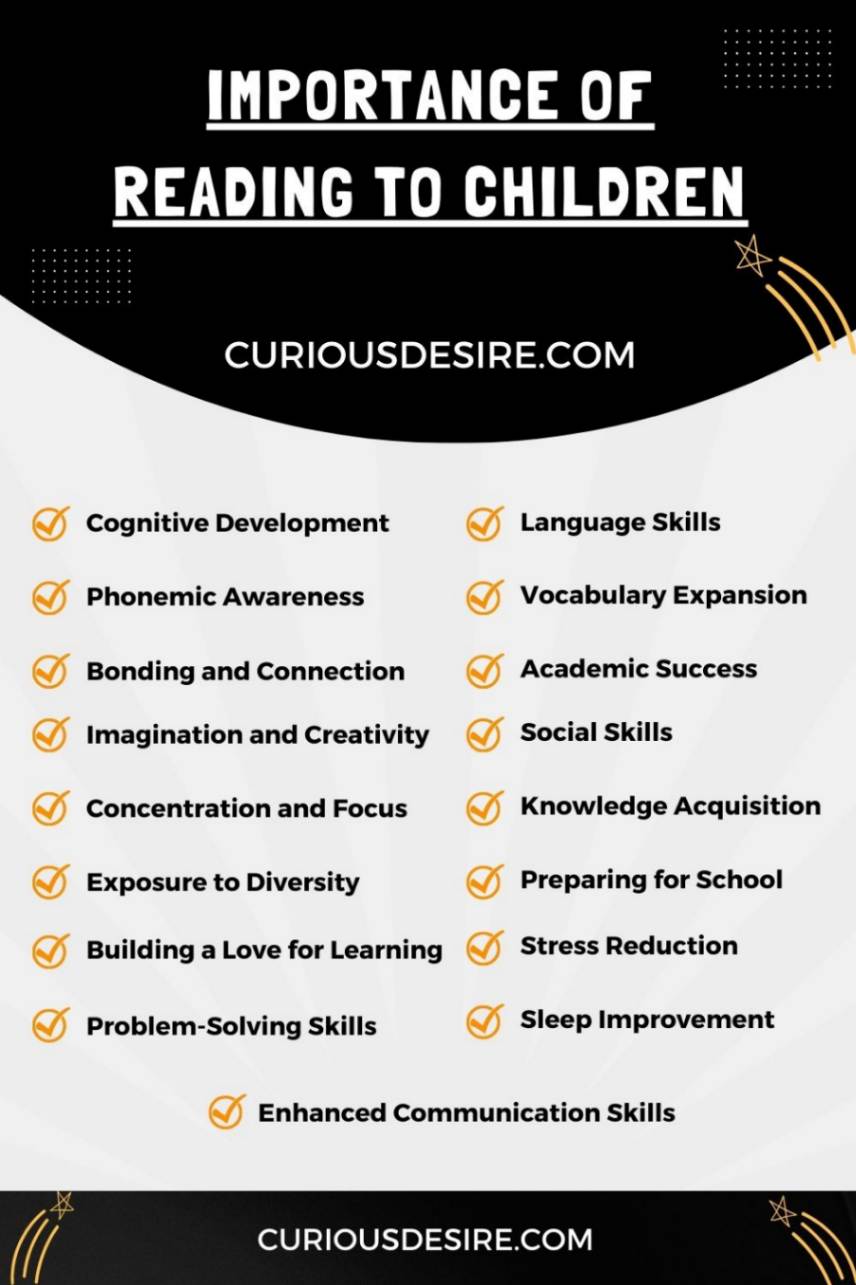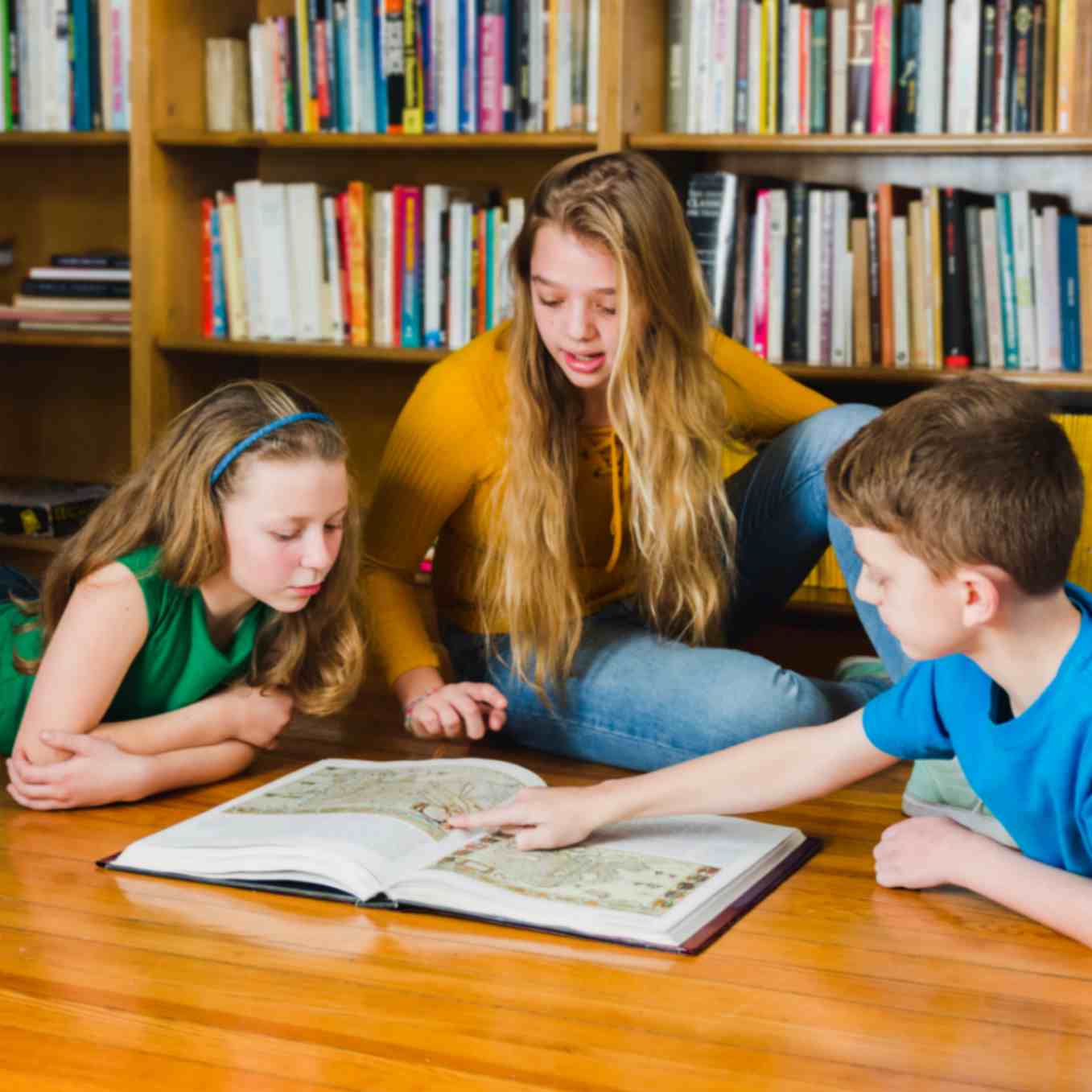Reading to little ones is like opening a door to a world of imagination and knowledge. It’s a special key that helps them grow their language skills, become great listeners, and get ready to understand all sorts of written words.
The magic of reading isn’t just about stories; it’s a journey that boosts their thinking skills and helps their minds grow smarter.
Let’s explore the amazing adventure of reading to children and see how it makes their imagination bloom and their understanding of the world expand!
Here are 5 common reasons for the importance of reading to children:
- Cognitive Development
- Language Skills
- Vocabulary Expansion
- Phonemic Awareness
- Academic Success
1. Cognitive Development
Reading to a child is important for their brain growth, boosting thinking skills and imagination. When kids hear stories of characters overcoming challenges, they think about solving real-life problems.
This not only makes learning fun but also makes their memory and thinking better. Regular storytelling builds a strong base for smart thinking, problem-solving, and a love for learning.
Take, for instance, books like “The Very Hungry Caterpillar” by Eric Carle. This story, with its colorful pictures and the caterpillar turning into a butterfly, sparks creative thinking and helps the child understand things better.
Exploring concepts like the life cycle and days of the week, becomes a fun and educational journey, supporting overall brain development in children.
2. Language Skills
Developing language skills in children is important for effective communication and learning. When you read to a child, it helps them learn new words and how to use them.
For instance, reading a book with different animals introduces the names of creatures and how they sound. This not only makes language exciting but also expands their vocabulary, making it easier for them to express themselves.
Regular reading becomes a playful way for children to grasp new words, enhancing their language skills and setting a strong foundation for effective communication throughout their lives.
Consider the joy of books like “Brown Bear, Brown Bear, What Do You See?” by Bill Martin Jr. This simple yet engaging story introduces various colors and animals, making language learning enjoyable and memorable for young minds.
3. Vocabulary Expansion
Improving vocabulary is super important for talking and learning better. So, when you read to a kid, they get to know new words in stories, and it adds more words to their word collection.
Let’s say you read a book about different places or jobs – it introduces them to special words related to those things. This not only makes learning words fun but also makes it useful for talking and expressing ideas.
Doing this reading thing regularly is like a cool game for kids to pick up lots of different words, making their talking better and clearer.
4. Phonemic Awareness
Getting good at phonemic awareness is important for being a great reader and understanding language well.
So, when you do things like reading books that rhyme or playing with words, it helps kids notice and get what sounds words have when we talk.
Imagine reading a cool book with rhymes, like the classic “Hop on Pop” by Dr. Seuss. It’s like a fun game for kids where they get used to how words sound, which helps them read and spell even better as they grow.
5. Academic Success
Doing well in school is important for many things, and reading plays a big role. When kids read regularly, it helps them learn a lot of stuff, not just from textbooks but also from interesting stories.
This learning, sparked by reading has the following benefits:
- Helps in understanding school lessons better.
- Improves grades by making learning easier.
- Boosts confidence in answering questions and participating in class.
For instance, imagine a kid who reads a book about space. They not only learn cool facts about planets but also pick up science words.
When they have a science test in school, it’s easier for them to remember and understand because they already know a bit from their reading adventure. This makes doing well in school more fun and achievable.
6. Bonding and Connection
Reading together creates special moments between parents or caregivers and children. When you read to a child, it’s like sharing an adventure. It helps in
- Strengthens the bond between parents/caregivers and children.
- Creates positive and happy memories.
- Promotes a sense of security and trust.
For example, think about a parent reading a bedtime story. It’s a time when the child feels cozy and cared for, sharing a story and some laughs.
This routine of reading together becomes a cherished moment, making the child feel loved and forming a strong connection. It’s not just about the story; it’s about the warmth and togetherness it brings.
7. Emotional Intelligence
Developing emotional intelligence in children is vital for their well-being. Reading plays a significant role in this by exposing them to various emotions through stories.
When kids read about characters going through different feelings, it helps them understand and manage their own emotions better.
For instance, a book like “The Feelings Book” by Todd Parr introduces various emotions in a simple and relatable way.
This not only enhances their emotional awareness but also equips them with the skills to handle and express feelings, promoting healthier relationships and self-awareness.
8. Imagination and Creativity
Encouraging a child’s imagination and creativity is like giving them superpowers for learning and problem-solving. Reading, especially stories that let their imagination soar, helps them think outside the box.
Consider the magic of “Where the Wild Things Are” by Maurice Sendak; it opens a world of imagination where a child’s creativity knows no bounds.
This imaginative exploration not only makes learning fun but also nurtures creativity, a skill important for innovation and adaptability in various aspects of life.
Overall, promoting imagination and creativity through reading provides children with the tools to approach challenges with inventiveness and joy.
9. Concentration and Focus
Engaging in activities that demand sustained attention, such as reading a captivating story or solving complex puzzles in books, plays a fundamental role in developing a child’s concentration and focus.
By involving themselves in the narrative, children learn to tune out distractions, actively follow the storyline, and comprehend the characters’ experiences.
This not only enhances their academic performance by promoting effective learning but also establishes an important foundation for lifelong skills in sustained attention and focused problem-solving.
10. Social Skills
Sharing and discussing stories, whether with parents, caregivers, or fellows, is a powerful catalyst for developing important social skills in children.
When engaged in a shared reading experience, children learn to express their thoughts, listen actively, and consider diverse perspectives, contributing to the growth of effective communication skills.
For example, reading a story that explores themes of friendship or teamwork provides opportunities for children to discuss their own experiences and understand the feelings of others.
This cooperative interaction nurtures empathy and builds a solid foundation for positive relationships and effective collaboration, preparing children for success in various social settings throughout their lives.
11. Exposure to Diversity
Being exposed to diverse stories and experiences through reading is important for a child’s understanding of the world.
Books that feature characters from various backgrounds, cultures, and perspectives provide children with an opportunity to explore diversity.
For instance, reading a story about a child in a different country or with different traditions broadens their awareness and promotes acceptance.
This exposure promotes a mindset of inclusivity and respect for differences, preparing children to explore a diverse and interconnected world.
12. Knowledge Acquisition
Reading is a powerful tool for acquiring knowledge beyond what is taught in the classroom. When children read a variety of books, they gain information about different subjects, places, and historical events.
For example, exploring books on space introduces them to planets and galaxies, expanding their understanding beyond everyday experiences.
This broad knowledge base not only enhances their academic performance but also nurtures a curiosity for learning that lasts a lifetime, preparing them to handle various challenges with a well-informed perspective.
13. Preparing for School
Engaging in reading activities is a valuable way to prepare children for school. Reading books with letters, numbers, and basic concepts helps them become familiar with the building blocks of education.
For example, a book that playfully introduces counting or the alphabet can make learning these fundamental skills enjoyable.
This early exposure to educational concepts through reading sets a positive foundation for formal learning, making the transition to school smoother and more enjoyable for children.
14. Building a Love for Learning
Encouraging a love for learning from an early age is important for a child’s lifelong educational journey. Reading, with its engaging and enjoyable nature, serves as a key driver in promoting this passion.
When children find joy in exploring books, they develop a positive attitude towards learning that extends beyond the classroom.
For instance, reading a story about a fascinating topic can spark curiosity, creating a foundation for a continuous and enthusiastic exploration of knowledge.
This love for learning becomes a valuable asset, driving a child’s motivation to explore new ideas, subjects, and challenges throughout their academic and personal journey.
15. Stress Reduction
Engaging in reading activities provides children with a valuable means of stress reduction. The immersive and calming nature of reading can serve as a peaceful escape from daily pressures.
For example, getting lost in a captivating story allows children to temporarily step away from stressors, promoting relaxation and mental well-being.
This positive association with reading as a stress-relief tool establishes healthy coping mechanisms, teaching children to manage stress constructively.
By incorporating reading into their routine, children not only find solace in books but also develop a valuable skill for maintaining emotional balance in various life situations.
16. Sleep Improvement
Creating a peaceful bedtime routine, such as reading a story, is like a magic trick that helps kids sleep better. Just imagine reading a cozy bedtime story like “Goodnight Moon” by Margaret Wise Brown.
The gentle words and calming pictures create a quiet and relaxed feeling, signaling to the child that it’s time to wind down.
This bedtime ritual becomes a special bridge, helping them transition from the excitement of the day to a more peaceful state, setting the stage for a good night’s sleep.
The rhythmic pattern of bedtime reading with familiar stories becomes a reassuring introduction to a restful night’s sleep, contributing to their overall well-being.
17. Enhanced Communication Skills
Reading regularly, especially through interactive storytelling and talking about books afterward, plays a big part in making a child better at communicating. Hearing different words and stories helps them understand language better.
When they chat about characters, plots, and what they think about the story, it becomes a fun way for them to express themselves, listen well, and share their thoughts.
This way of reading not only makes them better at using language but also sets the stage for being good at communicating in different situations, not just during storytelling.
18. Problem-Solving Skills
Reading stories where characters face and solve problems is like a training ground for kids to become good at solving problems in real life. Imagine reading a story where someone has to figure out how to climb a big mountain.
Kids go on a learning adventure, thinking about what could work, understanding what might happen next, and seeing how actions have different outcomes.
This kind of storytelling not only helps kids become practical and smart problem-solvers but also teaches them to handle challenges in their own lives with a strong and flexible mindset.
The stories act like helpful guides, making kids think and act wisely when they face real-world problems.
How to Develop a Habit of Reading to Child?
Promoting a love for reading in children starts early and involves creating positive routines.
From cozy reading spaces to celebrating achievements, these steps aim to make reading an enjoyable and lasting part of a child’s daily life. Let’s step into simple yet effective strategies to nurture a lifelong love for books.
1. Start Early
Introducing books to your child from infancy promotes a positive association with reading. Even if they don’t comprehend the words initially, the exposure to the colors, shapes, and soothing voice creates a foundation for a lifelong love of books and stories.
2. Make it Routine
Establishing a consistent reading routine, like bedtime stories or a designated reading time during the day, provides a predictable structure.
Routine helps your child anticipate and look forward to these moments, making reading an integral and anticipated part of their daily activities.
3. Choose Engaging Books
Selecting books with captivating illustrations, interesting narratives, or interactive elements ensures an engaging reading experience.
The visual and tactile appeal of these books captures your child’s attention, making the reading time enjoyable and encouraging curiosity about the content.
4. Create a Cozy Reading Space
Designate a comfortable and well-lit reading nook in your home. This dedicated space serves as a cozy haven, creating a positive and inviting atmosphere for shared reading.
The physical setting contributes to the overall experience, making it a place associated with warmth and enjoyment.
5. Be a Reading Role Model
Modeling the joy of reading by letting your child observe you immersed in a book sets a powerful example.
Children are influenced by what they see, and your positive reading behavior encourages them to view reading as a pleasurable and valuable activity.
6. Encourage Participation
Actively involving your child in the reading process enhances their engagement. Allowing them to turn pages, point to pictures, or even create their stories based on the images promotes a sense of participation and ownership, making reading a collaborative and enjoyable activity.
7. Visit the Library
Turning library visits into enjoyable outings exposes your child to a variety of books and stories. Allowing them to choose books based on their interests promotes autonomy and excitement about reading, turning the library into a place associated with exploration and discovery.
8. Integrate Books into Daily Activities
Incorporating books into daily routines, such as including them in playtime or associating them with specific events like holidays, effortlessly weaves reading into their day.
This integration reinforces the habit, making reading a natural and expected part of their daily lives.
9. Celebrate Achievements
Recognizing and celebrating your child’s reading milestones, whether it’s completing a book or identifying new words, builds positive reinforcement.
This celebration boosts their confidence, promoting a sense of accomplishment and excitement for future reading journeys.
10. Be Patient and Flexible
Acknowledging that developing habits takes time is important. If your child doesn’t initially show interest, be patient and open to trying different approaches or exploring various book genres until you find what captures their attention.
Being adaptable to their evolving preferences ensures a personalized and enjoyable reading experience.
Why Reading to Child is Important?
In the wonderful world of parenting, reading to your child isn’t just a routine—it’s a magical journey that shapes their entire universe. Beyond the cozy moments and shared giggles, it’s a powerhouse for their growing minds.
When you step into a story together, it’s like giving their brains a workout. The characters, the plots, and the exciting twists make their brains stronger, turning them into little problem-solving champs.
And guess what? It’s not just about learning; it’s about creating this enchanting bond, a secret world where stories become shared treasures.
So, why is reading to your child important? It’s the key to a smarter, happier, and more connected little explorer. With each page turned, you’re not just reading a story; you’re building a future filled with curiosity, joy, and the warmth of shared tales.
Importance of Reading to Child FAQs
1. Why is reading important for my child?
Reading is like a superpower for their brain, making them smarter, better at solving problems, and even great at talking with others.
2. How can I make reading fun for my child?
Turn it into an adventure! Use funny voices, ask them to predict what happens next, or let them choose the story – making it exciting and enjoyable.
3. When should I start reading to my baby?
Start from the beginning! Even if they’re tiny, babies love the sound of your voice, and it helps them learn about words and feelings.
4. Can I read the same book over and over?
Absolutely! Repetition helps them remember words, and they enjoy the comfort of familiar stories. It’s like a cozy hug in book form.
5. How long should our reading time be?
Keep it short and sweet, especially for little ones. Even 10-15 minutes can create a happy reading routine without losing their interest.
6. What if my child doesn’t seem interested in reading?
Be patient and try different books or styles. Find what they like, whether it’s silly stories, adventures, or even books about their favorite toys.
7. Can I ask questions while reading?
Absolutely! Questions make it interactive. Ask what they think will happen next, or how a character feels. It’s like a mini book club for two!
8. How can I encourage my child to read on their own?
Lead by example! Let them see you enjoying books, and have a variety of books around. Gradually, they’ll be curious and want to explore the magical world of reading independently.
Resources Used For The Research:



